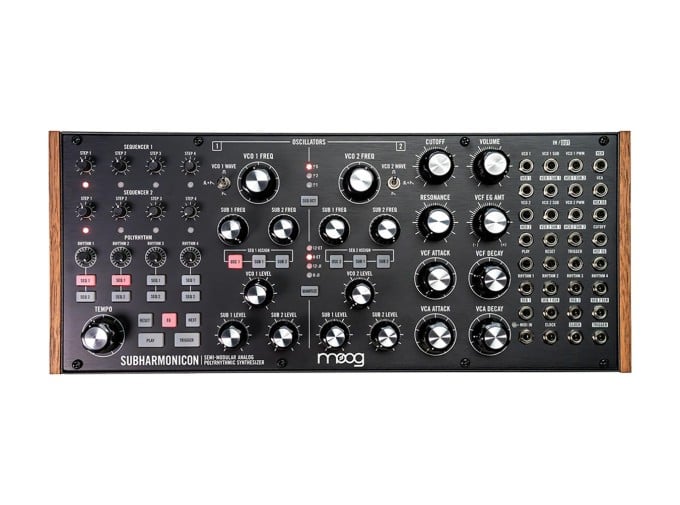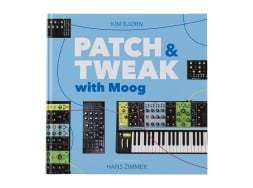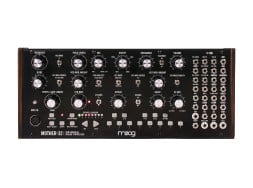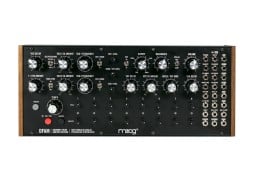MoogSubharmonicon Semi-Modular Analog Synthesizer
-
 Free
Free
Shipping -
 No Hassle
No Hassle
Returns -
 Extended
Extended
Warranty
Moog Subharmonicon
Once just a workshop instrument, the Moog Subharmonicon is now being released to the general public—so now all can venture into the world of subharmonics and polyrhythms and how they create unique relationships based on their interaction. It exists at the intersection of music and math. The Subharmonicon takes its roots from analog music inventions from the 1930's and 1940's, the Trautonium and Rhythmicon. The Trautonium created subharmonics by dividing the frequency of the master oscillators. While the Rhythmicon, designed by Leon Theremin, created polyrhythms derived from multiplications of the primary tempo.
The Subharmonicon features two VCOs, four subharmonic generators, two four-step sequencers, and four rhythm generators. A waveform contains the fundamental frequency of the note it is tuned to, such as A at 440Hz. Harmonically rich waveforms such as sawtooth waveforms, have a series of harmonics above that fundamental frequency—and the subhamonic series at work in the Subharmonicon inverts this natural order of overtones. The four sub-oscillators can be divided from the two oscillator's base frequency down to up to four octaves from the fundamental to create stacked, harmonically related tones. The two VCOs and four sub-oscillators can be tuned to create up to six note chords.
The sequencer section features two four-step sequencers, which may seem simple at first glance, but in reality are capable of advanced functionality. The sequencer rate is not only controlled by the tempo knob, but rather the subharmonic divisions. These can be divided by an integer from 1 (no division) to 16 divisions of the master clock. This means it will take 16 clock pulses for the sequencer to move one step. The subharmonic used to clock the sequencer can be selected using buttons. These subdivisions of the master tempo make the simple four-step sequencer perform much more complicated sequences. These may take quite a bit longer than you might expect to repeat. The sequencer can be routed via switch to affect the primary VCO pitch or the subharmonic frequency. Onboard quantizers allow you to constrain the sequencer notes to specific scales such as equal temperament or just intonation.
And of course, it wouldn't be a Moog synthesizer without a killer low pass ladder filter. This classic, full bodied low pass filter can be used to filter out harmonics present at the output stage. Harmonics can be removed using filtering and emphasized using the resonance of a filter which highlights the harmonics at the cutoff frequency via feedback. The VCA and VCF have independent envelope shapes with attack and decay stages.
The Subharmonicon is semi-modular and requires no patching in order to make sound. However, the functionality can be expanded with the 32-point patchbay. This allows you to patch program the Subharmonicon by rerouting the internal connections or integrate it with external modular or semi-modular gear such as the Moog Mother 32 or DFAM. Additionally, the Subharmonicon features a MIDI input, allowing it to be controlled from external MIDI devices.
With this instrument, Moog has ventured outside of what a traditional semi-modular device can be. Not just a monophonic bass line creator, the Subharmonic is capable of complex sequencing and rich tones derived from six oscillators. It challenges the end user to think about synthesis in new and exciting ways while retaining the parts of a Moog synthesizer that make them so loved.
Subharmonicon Features
- Subharmonic semi-modular synthesizer
- Two VCOs
- Four sub-oscillators that can be tuned to subdivisions of master VCO frequencies
- Two four-step subharmonically clocked sequencers
- Sequencers can affect VCO pitch or subdivisions
- 32-point patchbay for rerouting signals and integrating with external modular devices
- Moog low pass ladder filter
- Analog VCA
- MIDI integration
- Amp and filter two-stage envelopes
- Patch bay: 32 points
- MIDI type A included
- Included power supply: +12DC 1200mA, can also be powered by a Eurorack power supply
- Dimensions: 4.2h x 12.57w x 5.24d" / 10.67h x 31.93w x 13.31d cm
- Weight: 3.5lbs/1.58kg
 Artist Picks: Best Gear of the Year 2022Synthesizers, Drum Machines, Effect Pedals, Eurorack Modules, and More!Best Synths for BeginnersHow to Choose Your First SynthesizerBest Synthesizers of 2020Affordable Desktops to the Return of Vintage ClassicsMeet Moog's MAVISAn Affordable (and Excellent) Desktop Semi-Modular SynthesizerWhich Moog Semi-Modular Synth is Right for Me?Mavis, Mother-32, DFAM, + Subharmonicon ComparisonMoog Subharmonicon Semi-Modular SynthSubverting Rhythm and HarmonyExploring the SubharmoniconLive Walkthrough and Q&ABuying Guide: Semi-Modular SynthesizersOur Favorites from Moog, Make Noise, Bastl, Arturia, and MoreGoing Modular: Should You Buy a Modular Synthesizer?Cautionary Tales, Why, Why Not, and HowDeep Dive: Vintage Moog Modular Synthesizer FiltersDefining the Moog Sound
Artist Picks: Best Gear of the Year 2022Synthesizers, Drum Machines, Effect Pedals, Eurorack Modules, and More!Best Synths for BeginnersHow to Choose Your First SynthesizerBest Synthesizers of 2020Affordable Desktops to the Return of Vintage ClassicsMeet Moog's MAVISAn Affordable (and Excellent) Desktop Semi-Modular SynthesizerWhich Moog Semi-Modular Synth is Right for Me?Mavis, Mother-32, DFAM, + Subharmonicon ComparisonMoog Subharmonicon Semi-Modular SynthSubverting Rhythm and HarmonyExploring the SubharmoniconLive Walkthrough and Q&ABuying Guide: Semi-Modular SynthesizersOur Favorites from Moog, Make Noise, Bastl, Arturia, and MoreGoing Modular: Should You Buy a Modular Synthesizer?Cautionary Tales, Why, Why Not, and HowDeep Dive: Vintage Moog Modular Synthesizer FiltersDefining the Moog SoundThe Subharmonicon is built around divider circuits. There are two VCOs that each have two dividers that output frequencies between the base frequency 1/1, an octave below 1/2, an octave and a fifth below 1/3, two octaves below 1/4, two octaves and a fourth below 1/5, all the way down to four octaves below 1/16. The two oscillators and the four subdivisions can be mixed together into six note chords that span multiple octaves, the oscillators then of course go through a Moog ladder filter. There are a pair of envelopes for the VCA and VCF.
The sequencing also works with subdivisions of the tempo clock, there are four dividers that divided the master clock from 1/1 to 1/16 in integer divisions. These four dividers can trigger the envelopes and clock the two four step sequencers. The sequencers can then modulate the pitch of the two main VCOs, or select which divisions the subdividers are set to. Since the Subharmonicon is semi-modular its has a patch bay where different signal and control routing setups can be experimented with. The patch bay also makes connecting the Subharmonicon to a Mother 32, DFAM, or any other semi-modular or eurorack synth easy.
In this video we showed a combination of the Subharmonicon by itself as well as with a DFAM for percussion and with a Cooper FX Outward V2. The sidechain style patch at 5:09 uses a Ritual Electronics Anima Function generator to create the sidechain envelope and the Subharmonicon is going through a Tiptop Echoz delay module.
They take a look at their favorites including the Herbs & Stones Liquid Foam, Moog DFAM, Buchla 208c, Make Noise Strega, as well as few effect pedals and more!




